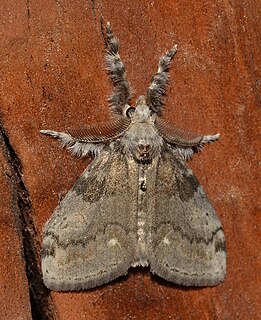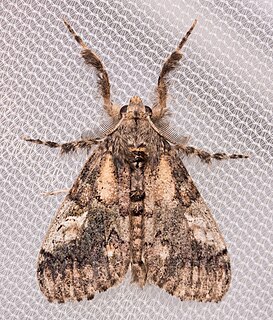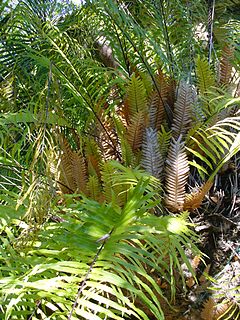Nesara is a genus of moths in the family Lasiocampidae. The genus was erected by Francis Walker in 1855.

Orgyia leucostigma, the white-marked tussock moth, is a moth in the family Erebidae. The species was first described by James Edward Smith in 1797. The caterpillar is very common especially in late summer in eastern North America, extending as far west as Texas, California, and Alberta.

Aglaomorpha fortunei, commonly known as gu-sui-bu, is a species of basket fern of the family Polypodiaceae. The plant is native to Eastern Asia, including eastern China.

The Callimorphina are a subtribe of woolly bear moths in the family Erebidae. The subtribe was described by Francis Walker in 1865. Many of these moths are easily confused with butterflies, being quite brightly colored and somewhat diurnal. Their antennae are not thickened into "clubs", which is a typical characteristic of butterflies.

Aglaomorpha is a genus of tiger moths in the family Erebidae.

Aplocera is a genus of moths of the family Geometridae.
Teulisna is a genus of moths in the family Erebidae. The genus was erected by Francis Walker in 1862. They are found in Sri Lanka, India, Myanmar, Borneo and Java.

Dasychira is a genus of tussock moths in the family Erebidae described by Jacob Hübner in 1809. They are well distributed all over Africa, Europe, Madagascar, Japan, China, India, Sri Lanka, Myanmar, Java and Australia.

Dasychira plagiata, the northern pine tussock or northern conifer tussock, is a moth of the family Erebidae. The species was first described by Francis Walker in 1865. It is found in North America from Newfoundland and Labrador to Alberta, in Massachusetts, New York and North Carolina.

Temnora is a genus of moths in the family Sphingidae.
Asota plagiata, the two-spots tiger moth, is a moth of the family Erebidae first described by Francis Walker in 1854. It is found in the northern half of Australia.

Tiracola plagiata, the cacao armyworm, is a moth of the family Noctuidae. The species was first described by Francis Walker in 1857. It is found from south-east Asia, South India, Sri Lanka, Myanmar to the South Pacific Islands, including the northern two-thirds of Australia.

Aglaomorpha is a genus of ferns in the subfamily Drynarioideae of the family Polypodiaceae. The Pteridophyte Phylogeny Group classification of 2016 uses this genus name, while other sources use Drynaria to include Aglaomorpha. Species are commonly known as basket ferns. As circumscribed in PPG I, the genus contains around 50 species.

Aglaomorpha histrio is a moth of the family Erebidae first described by Francis Walker in 1855. It is found in Korea, Japan, China and Taiwan.
Castulo plagiata, the yellow-banded footman, is a moth of the subfamily Arctiinae. The species was first described by Francis Walker in 1854. It is found in the Australian states of New South Wales, Victoria and Tasmania.
Teulisna plagiata is a moth in the family Erebidae. It was described by Francis Walker in 1862. It is found on Borneo. The habitat consists of lower montane forests.
Caciomorpha is a genus of beetles in the family Cerambycidae, containing the following species:










